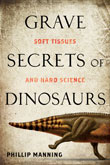|
GEOMEDIA
Check out the latest On the Web links, your connection to earth science friendly Web sites. The popular Geomedia feature is now available by topic.
Book review
 |
Grave Secrets of Dinosaurs: Soft Tissue and Hard Science by Phillip Manning. National Geographic Society, 2008. ISBN 9781426202193. Hardcover, $28.00. |
In 1999, then-16-year-old Tyler Lyson went fossil hunting in the Hell Creek Formation badlands close to his home in North Dakota. Three tail bones poking out of the dirt piqued his interest, but he didn’t have time to examine the spot closely until 2004. His return marked the beginning of one of the most significant dinosaur excavations in history. Lyson and his team unearthed what may be the most intact mummified dinosaur ever found.
British paleontologist Phillip Manning of the University of Manchester, who teamed up with Lyson shortly after the discovery, chronicles the painstaking excavation and analysis of the colossal hadrosaur, named Dakota, in his new book Grave Secrets of Dinosaurs: Soft Tissue and Hard Science.
The book provides an intriguing glimpse into the lives of paleontologists when they are truly in their element, and it’s certainly a worthwhile read in that sense. However, the book contains some factual errors. Additionally, although Manning outlines the principles that underlie the various high-tech analytical techniques he and his colleagues use on Dakota, his descriptions are sometimes misleading or inaccurate. Still, by detailing how scientists study dinosaurs, Grave Secrets of Dinosaurs will be interesting to paleontologists and dinosaur lovers alike.
The book covers the methods and techniques that the research team is using to examine the dinosaur, but Manning is careful not to give away much in terms of the actual data, which, he says, will be reported in peer-reviewed journals in the coming months.
This winter, Manning spoke with freelance writer Nicole Branan about Dakota and what it means for paleontologists.
NB: What made the finding of Dakota so special?
PM: Finding dinosaur bones is not uncommon. To find a semi-articulated skeleton is rare though, and to find an articulated skeleton is breathtaking. But to find one with soft tissue preservation covering large portions of the animal, including the skin envelope, tendons and ligaments, is what makes this a completely unique find.
NB: Why is soft tissue preservation important?
PM: When you are reconstructing an extinct species, you are left with the disjointed sentences that the fossil record throws at you. When you are trying to stitch together an image of what the animal looked like, how it behaved and how it functioned as a living organism, you need large amounts of information, which are usually unobtainable. But based on the soft tissue preservation in Dakota, we can determine things like muscle volume and mass, even down to the morphology of the skin envelope. There are so many things that we can research on this animal.
NB: You describe in the book the entire process, from getting the specimen out of the ground to analyzing it in the lab. At what point did you realize that Dakota was no ordinary find?
PM: When Tyler Lyson found the specimen in 1999, he realized that it was a hadrosaur. But it was only when he and his Marmarth Research Foundation team went back in 2004 and started excavating that they discovered a distinct iron mineralization surrounding much of the skeleton. Tyler recognized that instantly as being fossil skin.
NB: That is different from a skin impression, correct?
PM: Yes, this is where the skin envelope itself has been replaced with minerals, giving it a three-dimensionality similar to the original skin. So, we have been able to look at this structure with a fidelity that has not been achievable before.
NB: The book emphasizes the fact that Dakota offered the opportunity to examine a prehistoric find with 21st century methods and technology. What can these modern techniques reveal?
PM: It’s really an approach to recording as much information as possible and as accurately as possible. For example, during the excavation process we used a laser surveying system, with which we could generate 3-D digital outcrop models, from which we could construct a 3-D map. Then, from the geochemical data relating to the specific environments represented in different packages of rock, we were able to gain an understanding of how our animal fit into these evolving environments. In the laboratory we are applying everything from vast CT imaging to molecular scale proteomics [study of proteins], which is unusual for a fossil, but this is one that we think deserves it.
NB: Where is Dakota going to be displayed for us to see?
PM: The Marmarth Research Foundation is keen to construct a museum in Marmarth, N.D., and the centerpiece of that museum will be Dakota. We hope that will happen in the next five to 10 years. I am in full support of this effort since it seems only right that such a unique fossil is displayed where it was found.

 Subscribe
Subscribe


